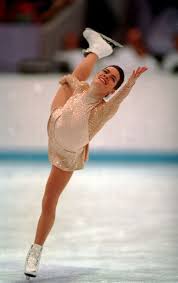In the dazzling world of figure skating where artistry meets athleticism, and beauty must co-exist with brutal discipline few names have endured with as much quiet strength as Nancy Kerrigan. Though she became a household name after the shocking events leading up to the 1994 Winter Olympics, Kerrigan’s true legacy lies in her contribution to the sport itself: elevating the standards of grace, poise, and perseverance in figure skating at a time when the spotlight often rewarded drama over discipline.
A Humble Beginning with Big Dreams
Born on October 13, 1969, in Stoneham, Massachusetts, Nancy Kerrigan was the youngest of three children in a working-class family. Her father, a welder and part-time ice resurfacer, often picked up extra jobs to fund her training. Unlike many elite figure skaters who trained in elite, high-budget environments, Kerrigan’s early career was grounded in grit, long hours, and quiet determination.
She started skating at age six and showed a natural talent for the sport. But it wasn’t just talent that pushed her forward it was relentless work ethic. By the late 1980s, she had emerged as a serious competitor, earning a spot on the U.S. national team and rising through the ranks with powerful jumps, clean lines, and an innate sense of grace.
Olympic Glory and Global Recognition
Kerrigan’s breakout moment came at the 1992 Winter Olympics in Albertville, France, where she won the bronze medal. She followed this with a silver medal at the 1993 World Championships, solidifying her position as one of the top skaters in the world. Her style elegant, fluid, and balletic stood out in a field that was becoming increasingly focused on technical difficulty.
Then came 1994.
In one of the most sensational moments in sports history, Kerrigan was attacked during a practice session ahead of the U.S. Figure Skating Championships. The assailant, later linked to the ex-husband of her rival Tonya Harding, struck her knee in an attempt to eliminate her from Olympic contention. Footage of Kerrigan crying, “Why? Why?” echoed across television screens worldwide.
Remarkably, she recovered in time for the Winter Olympics in Lillehammer, Norway, just weeks later. There, under immense pressure and global scrutiny, Kerrigan delivered one of the strongest performances of her career, earning the silver medal. It was a moment of triumph not just in competition, but in character.
Changing the Sport Without Flash
While some skaters dazzled with flamboyance or sought controversy to maintain relevance, Nancy Kerrigan represented the opposite: composure, dignity, and the belief that skating should be as much about art as it is about sport. She didn’t chase headlines headlines found her. And through it all, she stayed focused on her craft.
Her skating style influenced a generation. She reminded judges, audiences, and young skaters that elegance and storytelling mattered just as much as technical precision. Her costume choices, choreography, and emotional expression brought a classical sensibility back to the rink one that valued restraint over spectacle.
Legacy Beyond the Ice
After retiring from competitive skating, Kerrigan performed in ice shows, worked as a commentator, and later advocated for mental health and vision research (inspired by her mother’s partial blindness). She also competed in Dancing with the Stars, showing once again that quiet strength never fades.
Today, Nancy Kerrigan’s name may often be mentioned alongside a scandal, but those who know the sport understand her true impact. She changed figure skating by showing that greatness isn’t always loud. Sometimes, it glides silently across the ice, landing perfectly, then bowing with grace.

